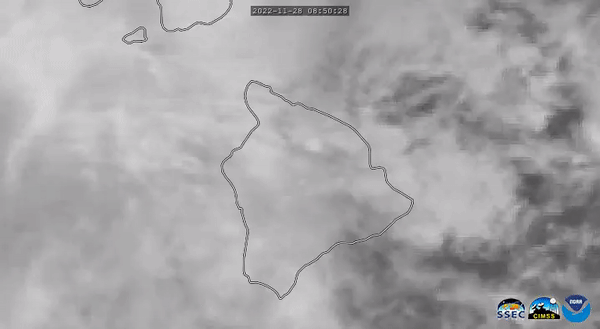Satellites watch Mauna Loa, world's largest active volcano, erupt in Hawaii (photos)

The world's largest active volcano has erupted after being quiet for 38 years.
Hawaii's Mauna Loa erupted on Sunday (Nov. 27) at 11:30 p.m. local time (Nov. 28 at 4:30 a.m. EST or 0930 GMT), releasing a large plume of ash and toxic gasses along with multiple lava flows. So far, the lava flows are contained within the volcano's summit and do not pose a threat to surrounding communities, according to a statement released by the United States Geological Survey (USGS) and Hawaii Volcano Observatory.
Satellites operated by the National Oceanographic and Atmospheric Administration (NOAA) observed the eruption from overhead this weekend, offering a bird's eye view of the sheer power of Mauna Loa and the dangers such an eruption can pose.
Related: How satellites have revolutionized the study of volcanoes
NOAA's GOES West satellite witnessed the eruption from its position in geosynchronous orbit. An animated image shared by NOAA shows both the heat signature of the eruption and a large plume of gas spreading to the northeast of the island of Hawaii (the "Big Island") following the event.
Around 11:30 p.m. HST last night, @NOAA's #GOESWest 🛰️ captured the eruption of Hawaii's #MaunaLoa volcano, inside @Volcanoes_NPS. This imagery shows the heat signature and the sulfur dioxide released from the #volcano's summit caldera, Moku‘āweoweo. pic.twitter.com/gHEG63rbLbNovember 28, 2022
Another image shared by NOAA Satellites Public Affairs shows the eruption in infrared, depicting in detail the heat created by the eruption.
#SATELLITE SPOTLIGHT: This infrared imagery from @NOAA #GOESWest🛰️ caught the #eruption of the #MaunaLoa #volcano (Moku‘āweoweo caldera) on Hawaii's Big Island overnight. NOAA's NWS Office in Honolulu has issued an Ashfall Advisory for the island until 10 a.m. HST today. #HIwx pic.twitter.com/MR4VvJ4iO7November 28, 2022
The USGS shared images of the resulting lava flow, which "are moving downslope to the north" of the volcano, according to a USGS tweet.
Breaking space news, the latest updates on rocket launches, skywatching events and more!
#MaunaLoa is erupting from vents on the Northeast Rift zone. Flows are moving downslope to the north. USGS Photos from Civil Air Patrol fight. #MaunaLoaErupts @Volcanoes_NPS @Hawaii_EMA @CivilDefenseHI pic.twitter.com/kUYWYPdk4LNovember 28, 2022
The National Weather Service's Honolulu office shared images of the resulting lava flow as it spilled out into Mauna Loa's caldera, the large hollow space inside the volcano.
At approximately 11:30 p.m. HST this evening, November 27, an eruption began in Moku‘āweoweo, the summit caldera of Mauna Loa, inside Hawai‘i Volcanoes National Park. Winds may carry volcanic gas and possibly fine ash and Pele’s hair downwind. Photo Credit: USGS pic.twitter.com/ai1vEFAwnXNovember 28, 2022
Meanwhile, images shared on social media reveal how the eruption turned the skies red throughout the surrounding Hawaiian islands.
UPDATE: View from Saddle Road of lava from Mauna Loa volcano eruption as of 1:30 am — Hawaii County Civil Defense working to confirm if any lava has flowed outside the summit caldera (pics: @KITV4 viewer AJ Taaca) pic.twitter.com/dN5reiq4PWNovember 28, 2022
Mauna Loa erupting at sunrise is literally the most amazing thing I’ve ever seen pic.twitter.com/YQdDfKHCMHNovember 28, 2022
According to a USGS statement, the eruption's "lava flows are contained within the summit area and are not threatening downslope communities." While that is currently reassuring news, the agency warns that "winds may carry volcanic gas and possibly fine ash and Pele's hair downwind." (Pele's hair is a fine volcanic glass that forms in hair-like strands as lava cools and stretches after ejected into the air.)
However, the agency stresses that volcanic eruptions such as these can be "very dynamic," meaning conditions — and the direction lava flows — can change at a moment's notice.
Follow Brett on Twitter at @bretttingley. Follow us on Twitter @Spacedotcom or on Facebook.

Brett is curious about emerging aerospace technologies, alternative launch concepts, military space developments and uncrewed aircraft systems. Brett's work has appeared on Scientific American, The War Zone, Popular Science, the History Channel, Science Discovery and more. Brett has English degrees from Clemson University and the University of North Carolina at Charlotte. In his free time, Brett enjoys skywatching throughout the dark skies of the Appalachian mountains.
